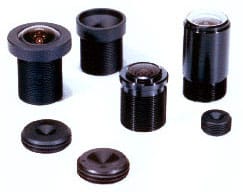High resolution lenses for machine vision — standard and custom lens design
Cornell CMOS Image Sensor
High Resolution Lenses for machine vision, instrumentation, inspection and vibration-sensitive applications. Standard and custom hi-res lens assemblies.

CMOS Image Sensor
Digital photography operates on a chip called an image sensor; the sensor is the heart of all digital cameras as it captures the intensity of the light that comes through the lens and converts it into an electronic signal. The signal is ultimately the photograph that you see.
Cornell scientists have taken this technology to a higher level by building image sensors for camera that provide detailed readouts of the intensity of the light as well as the incident angle of that light as it makes contact with the sensor. The ultimate result of this technology could lead to the next generation of 3D cameras and the ability to focus the photos after they’ve been taken. Assistant professor of electrical and computer engineering, Alyosha Molnar, was quoted as saying in an article published in the Ithaca Independent, “If I want to find something in 3-D space, if I just measure the amount of light hitting different locations, I know a little bit. I’ll get some sort of blurry blob…but if I know the incident angle of the light, I can triangulate back. So the question is how do you measure that?”
The research team’s solution was the “uniquely designed pixel for a standard CMOS (complementary metal-oxide semiconductor) image sensor.” Each of these seven-micron pixels, are displayed as an array and then fabricated on a CMOS chip; this is then made of a “photodiode under a pair of stacked diffraction gratings.”
Once a light is shined on the pixel and the top grate, it will create a diffraction pattern and changing the incident angle of the light will change the way the pattern interacts with the grating and this, in turn, determines how much light gets to the diode that is placed below. This entire process can be achieved in standard CMOS manufacturing at no additional cost.
As noted in the article, “The innovative design lets the chip detect information about the incident angle of the light striking it with more detail than a normal CMOS imager. All the pixels, each of which records a slightly different angle, producing an image containing both angular and spatial information. This information can be analyzed through the use of a mathematical function called the Fourier Transform, extracting both the depth of objects in an image, as well as allowing for computational refocusing, or after-the-fact focusing, of the image taken.”
It’s thought that this technology could also lend itself to the video industry because of the large files generated and the images that could be captured, manipulated and released. Universe Industries is a manufacturer of CMOS lenses, and a designer of optical lenses for industrial, medical, high tech and electronic applications lauds this new technology.